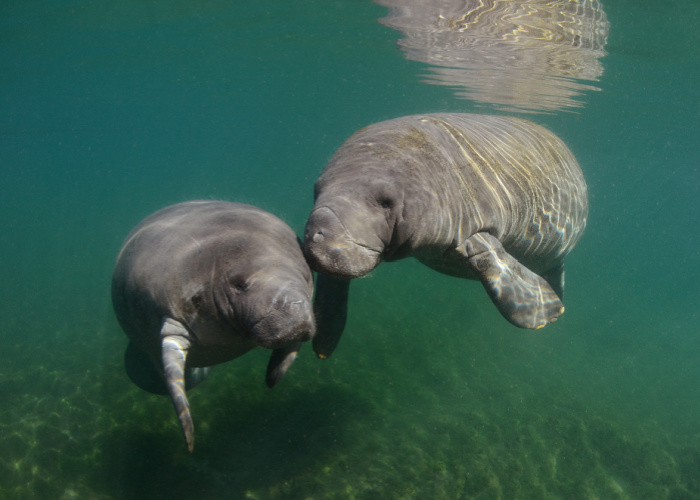As water temperatures rise, so do our chances of seeing manatees as they migrate from Florida. Murky waters make it difficult to discern true population numbers here in South Carolina, but that doesn’t mean we can’t plan for safe wildlife watching as we await their arrival!
The scientific order for these sea cows, Sirenia, pays homage to humans encountering manatees throughout history. Manatees were often mistaken for mythical mermaids, also referred to as their more villainous counterparts from Greek myth, sirens. Spotted over the centuries by sailors at sea, the first written record of manatees in North America was actually authored by Christopher Columbus back in 1492!
Food for Thought
Manatees have a robust, grey-brown body, soulful eyes and a paddle-shaped tail fluke that helps propel them forward as they feed along the sea floor. Manatees eat 10% of their body weight daily, and their bodies have adapted to support this behavior.
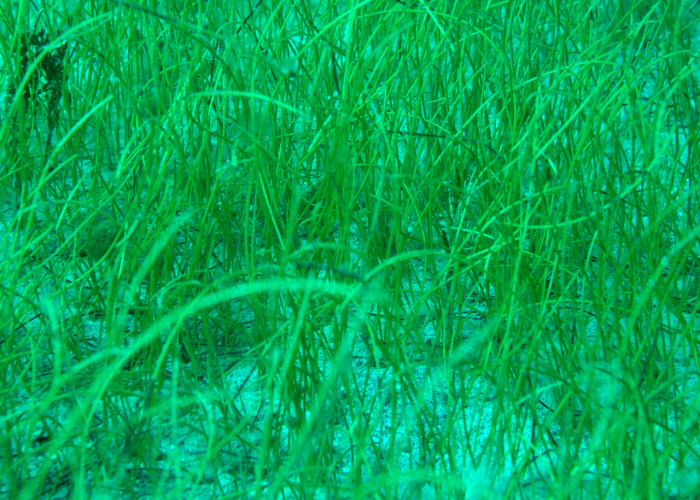 Seagrasses (Credit: NOAA CCMA Biogeography Team)
Seagrasses (Credit: NOAA CCMA Biogeography Team)Similar to the trunk of an elephant (their closest relative on land), manatees have prehensile lips that are capable of moving independently and allows them to easily grasp seagrass, which comprises the majority of their diet. While feeding, manatees will disturb large plumes of mud in their quest to consume it. Though considered herbivorous, they eat any and all of the animals found within the seagrass, treating snails and crustaceans as the seasoning on top.
Manatees also have “marching molars,” meaning teeth grow in the back of their mouths and push forward, enabling them to shed their front teeth that are well-worn from the constant foraging.
Finding Warmth in Winter
Contrary to popular belief, their stout body has a deceptively low fat content that alternates between two layers of muscle. Most of their internal body is actually taken up by their robust stomachs and intestines, which can be up to 150 feet long! Their fat is less for insulation and more for subsistence during the colder months, when feeding behavior slows. As winter arrives, manatees migrate inland into shallower waters of varying salinity, moving slowly and seeking warmth in rivers, springs and streams. Unfortunately, manatees have come to rely on artificial warm water sources, such as power plants and effluent from heavy industry, to keep them warm in winter; thousands have been spotted aggregating at power plants in the winter.
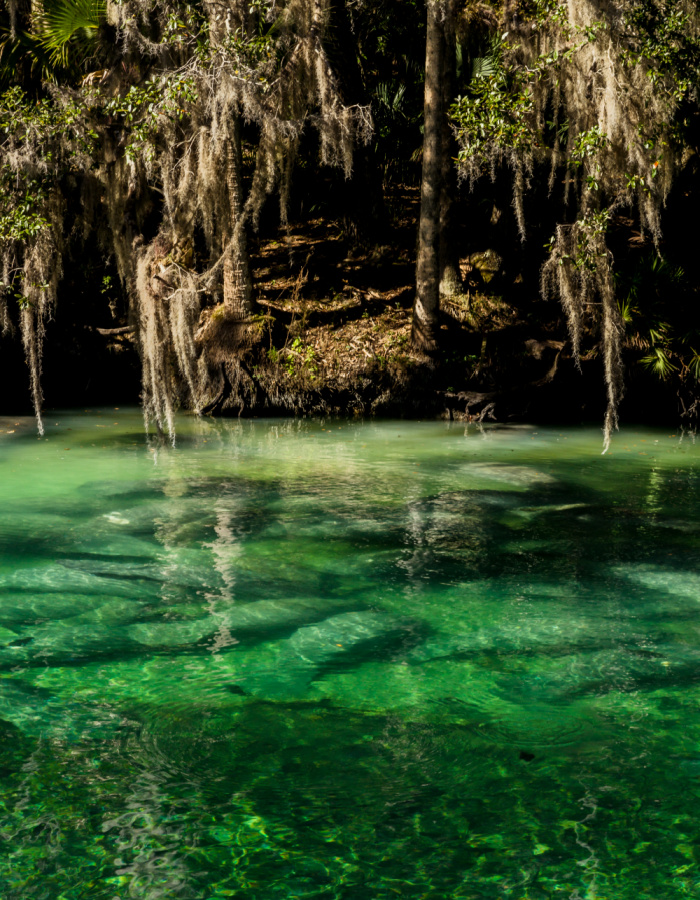 Manatees huddle together in inland springs.
Manatees huddle together in inland springs.As another means of regulating their temperature, manatees will wallow on the muddy bottom (as pigs do on land). Despite having heavy, solid ribs that can easily cause them to sink, their sizeable lungs help control their buoyancy and enable them to float and sunbathe on the water’s surface.
Though manatees have no known natural predators in the wild, human impact poses the biggest threat to their population.
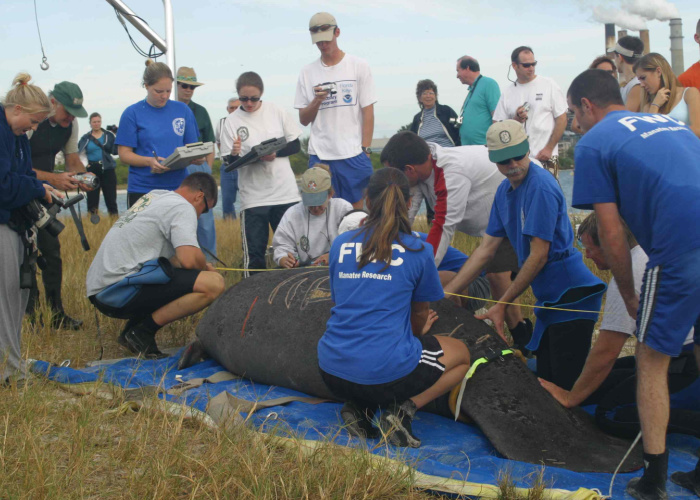 Dr. Sara McDonald (in a previous role) helps measure a manatee with visible propeller wounds. (Credit: FWC)
Dr. Sara McDonald (in a previous role) helps measure a manatee with visible propeller wounds. (Credit: FWC)Main Threats to Manatees
Boat Strikes
Because of their significantly slow pace, manatees are often injured by blunt force trauma from boats and motors as well as propellers, as they are unable to dodge quickly or they dive directly into the vessel’s path. Coupled with murky waters, captains might not see them prior to starting their engines, either.
Marine Entanglement
Discarded monofilament fishing gear can sink into the seagrass on which manatees feed, causing entanglement or accidental consumption. Crab pots can also cause injury, infections and even loss of limbs.
Harmful Algal Blooms (Red Tide)
Some algal blooms can produce a potent neurotoxin that, when inhaled or ingested, can fatally impact all animals in the food web, manatees included. Algal blooms are intensified by fertilizer and nutrient runoff from agriculture and coastal development. One type of algae when occurring in large volumes causes the water to look red, earning the nickname “red tide.” These algal blooms grow rapidly in warmer months and coat/contaminate manatees’ natural food source: seagrasses. The red tide neurotoxin (called brevetoxin) accumulates in the seagrass and in the animals living in the seagrass. Manatees will ingest the brevetoxin when feeding and also can inhale the brevetoxin if it becomes aerosolized.
Unusual Mortality Events – Varying Causes
Sometimes, manatee populations experience an unusual mortality event, meaning many died in a short period of time. In recent months, manatees have suffered from starvation in Florida due to water pollution impacting seagrass growth, the main food on their menu. These events are especially important to track, as they can serve as harbingers for imminent threats to all wildlife — sea turtles and shorebirds included — and start conversations on how to help water, wildlife and wild places.
Become a Safe Wildlife Watcher
As we start to see manatees arrive in South Carolina, you can become a safe wildlife watcher:
Keep your distance. Manatees are federally protected by the Marine Mammal Protection Act and Endangered Species Act, making it illegal to touch, feed or interact with them.
Don’t offer them freshwater from your docks. This promotes begging behavior and sends the dangerous message to manatees that it’s okay to approach docks, putting them directly in the path of propellers.
 Manatees floating just below the water's surface.
Manatees floating just below the water's surface.Scan the water’s surface prior to starting your boat engine. Look out for large swirls, called a “footprint.” These are signs that a manatee recently took a dive below.
Follow safe boating practices. Abide by speed limits and no wake zones.
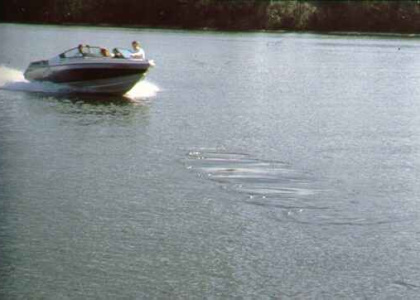 Manatee footprints on the water's surface. (Credit: FWC)
Manatee footprints on the water's surface. (Credit: FWC)If you spot an injured manatee, call the South Carolina Department of Natural Resources (SCDNR) at 1(800) 922-5431 or radio the U.S. Coast Guard on VHF channel 16. If you think you’ve hit a manatee, stay with them as you make the call.
Be prepared: Add SCDNR’s number to your phone in case you ever come across a sick or injured animal, and become part of the solution to protect what you love!
Published May 8, 2022


